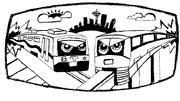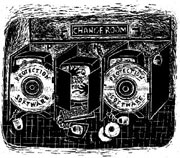WHILE SOUND TRANSIT’S detractors are busy writing light rail’s obituary, Seattle’s long-suffering monorail has taken on a golden glow. Suddenly, it has gotten difficult to find anyone who wants to speak out in public against the over-the-head electric trains. That appears to be partially due to the fact that the monorail is still in the conceptual stage and remains an open box into which everyone can stuff their own pet ideas.
Last week, the Elevated Transportation Company (ETC)—the quasi-governmental group charged with developing a monorail expansion plan complete with specific routes and a price tag—gave its unanimous support to a preliminary focus on a purposely vague route that would run from Ballard to downtown, then across the Duwamish River into West Seattle.
The ETC chose the study route from among seven transit corridors that city planners believe have the highest numbers of potential transit riders, the best overall costs per rider, and are places that most need some kind of improved form of public transportation.
Harold Robinson, ETC’s recently appointed executive director, stressed that the board was not being asked to set a route for the monorail at this point, but to define a priority area for further studies. “I just want to point out there’s a lot to do,” he said. “A corridor indication now is just a beginning.”
The ETC chose to pare down the area it wanted to study from a larger area that stretched from Lake City through Northgate, Ballard, and downtown to West Seattle.
“It would tie us in to a somewhat difficult study at this stage, and it runs the risk that we’d then have to pull back,” ETC member Alec Fisken said, explaining his support for studying a shorter route. “We’d be in a much better position to select a shorter route, and then say as we get into the study, ‘Yes, we could extend this.'” Fisken also pointed out that Sound Transit had not officially given up on its plans to run the light-rail line from the University District to Northgate.
The ETC board admitted that it was reluctant to look at any route configurations at this point that would appear to be in direct competition with Sound Transit’s light rail, even though the tone of the discussion made it clear that a number of board members doubted that the full light-rail system would ever be built.
King County Council member Rob McKenna (R-Bellevue), who is the Sound Transit board’s strongest critic of light rail, said it’s just good politics for the ETC board not to pick a fight with light rail at this point.
“They want to avoid appearing to be in competition with the light rail,” he said. “That is a sensible approach for them politically, because there’s so much political weight behind light rail that, if it appeared that they were competing with light rail or even providing an alternative to it, they would risk being crushed by the Seattle political establishment.”
By the same token, even Seattle’s light-rail supporters have begun to sound like monorail boosters.
“I see the light-rail system as being the regional system,” says King County Council member Greg Nickels (D-West Seattle), who is running for mayor. “The monorail, on the other hand, I see as an in-city system that will carry a lot of people, but not [have] nearly the carrying capacity that light rail has.” Even Mayor Paul Schell, who worked to kill ETC last year, has made positive remarks about the monorail’s potential to speed Seattle transit riders along.
Of course, it’s easy to love the monorail when it has no price tag, no specific routes, and no chosen technology. A display at last week’s ETC meeting showed how open-ended the concept remains: It illustrated the variety of technologies that fit under the broad definitions of a monorail—from magnetic levitation and air cushion-supported trains that could speed along silently at super speeds, to the comparatively old-fashioned concrete-and-rubber-tire monorail that runs from Seattle Center to downtown.
Everybody may love the sound of a train in the distance, but as it draws closer, people frequently flee the tracks in terror. Cost overruns have dogged rail systems all over the world. When specific streets are chosen for the monorail, concerns about whether it will block traffic or views will sap support. Still, at least for the moment, ETC seems to have learned some lessons from the failings of its regional big brother, Sound Transit.
For a start, they are busy taking the public’s pulse on what they are planning to propose—even while they move ahead at what, for a quasi-governmental agency, is breakneck speed to have a fully fleshed-out plan to present on the November 2002 ballot.








